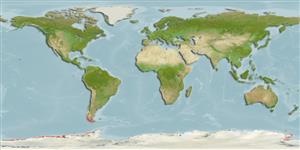Common names from other countries
Classification / Names / Names
Nombres comunes | Sinónimos | Catalog of Fishes (gen., sp.) | ITIS | CoL | WoRMS
Environment: milieu / climate zone / depth range / distribution range
Ecología
; rango de profundidad 10 - 30 m (Ref. 87801). Subtropical
Antarctic Pacific and Southeast Pacific: Antarctica and Chile. Subtropical to polar.
Length at first maturity / Tamaño / Peso / Age
Maturity: Lm ? range ? - ? cm
This species is usually found epizoic on other hydroids, e.g. Symplectoscyphus sp. at depths of 10 to 30 m (Ref. 87801).
Life cycle and mating behavior
Madurez | Reproducción | Puesta | Huevos | Fecundidad | Larva
Members of the order Anthoathecata are mostly colonial A-form hydroids. Life cycle: The zygote develops into planula inside the gonophore and is later released as an actinula which metamorphoses into polyp stage.
Häussermann, V. and G. Försterra. 2009. (Ref. 87801)
IUCN Red List Status (Ref. 130435)
CITES status (Ref. 108899)
Not Evaluated
Not Evaluated
Threat to humans
Harmless
Human uses
| FishSource |
Herramientas
Más información
Age/Size
Crecimiento
Length-weight
Length-length
Morfología
Larva
Abundancia
Fuentes de Internet
Estimates based on models
Preferred temperature
(Ref.
115969): -1.8 - -1.2, mean -1.8 (based on 28 cells).
